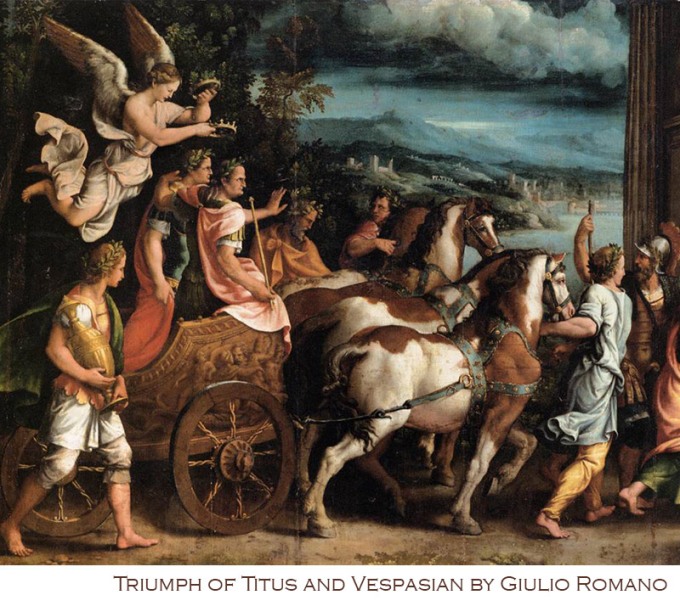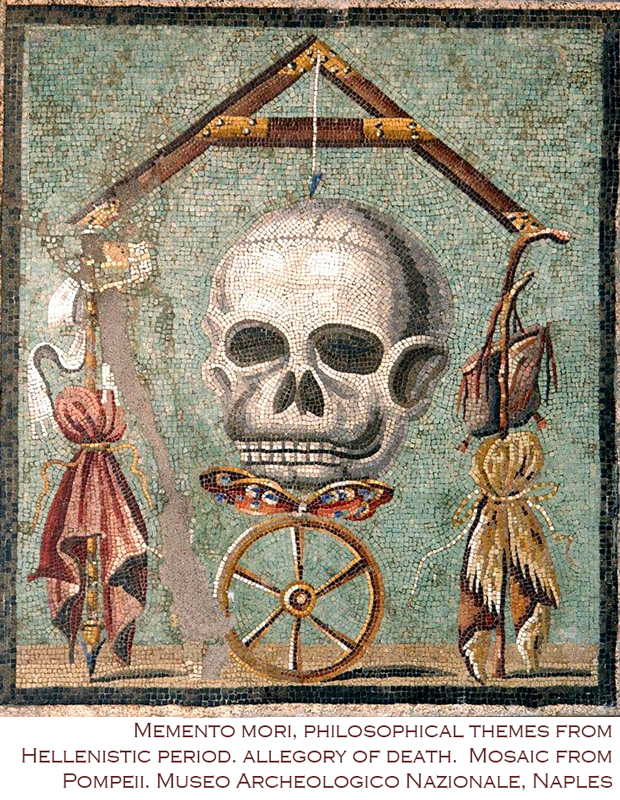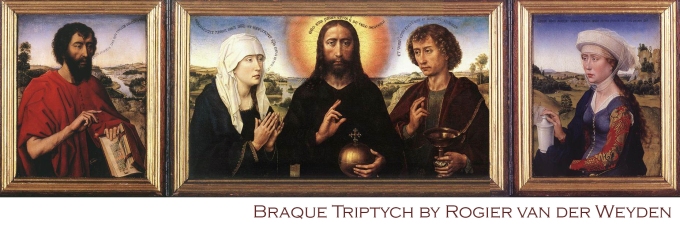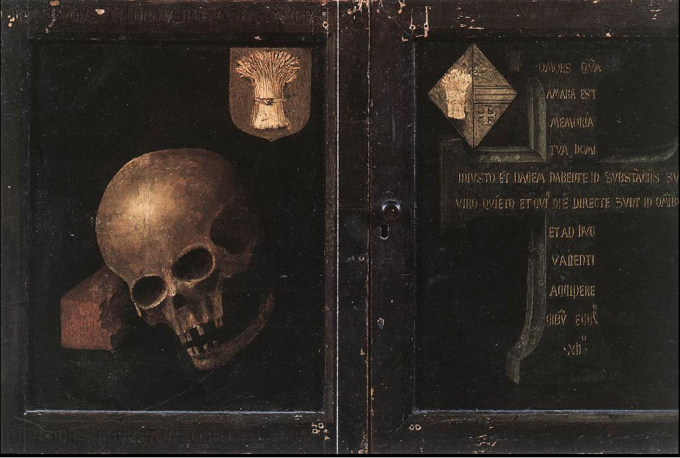
Part 1
While most of us shy away from contemplating our inevitable death in fear of alerting the scythe-carrying, all-dressed-in-trendy-black foot soldier, many ancient and medieval communities embraced and reflected deeply upon death. Not because they were macabre or Emo-like, but because they were realists and profoundly religious and therefore very much able and willing to contemplate life after death and those who could not or would not, were gently reminded of their mortality through art and the written and the spoken word
The phrase, Memento Mori, is believed to have originated in Rome (BCE) as a reminder that pride cometh before a fall, or in the case of victorious Roman Generals, that pride cometh before destruction and the possibility of losing your head in battle. During a parade or procession through the streets in celebration, a high ranking military official would have a slave trotting behind the convoy reminding the elated official that he was but a mortal man filled with hubris. This would probably be more vocalised while the General was trying to elicit a date for the night from the many eager women lining the streets throwing rose petals at him. So at every available opportunity the exhausted slave would breathlessly whisper into the Generals ear, “Respice post te! Hominem te esse memento! Memento mori!”
This assertion, and for those of us who failed Latin at school and were forced to join the baking class, translates into “Look behind you. Remember that you are but a man. Remember that you too will die!”
[How many of these slaves made it back for dinner is debatable]
The detailed mosaic portrays this perfectly below. The Skull and Level represents the ephemeral existence of life, irrespective of class, creed, gender, or financial standing. Everything is balanced in life and in death. On the left side is wealth shown with a maroon/purplish coloured cloak and on the right is poverty complete with beggars stick and sack. In the center is the death head hanging precariously by a thin thread from a plumb line and suspended just above the fragile wings of a butterfly that in turn rests upon the wheel of fortune.

Memento Mori was a means of “encouraging” the victor, the viewer or the listener to reconsider the vanity attached to this earthly realm and instead start perfecting the soul in anticipation of the next life, regardless of whether the person believed in one god, many gods, or even in reincarnation. How you live your very transient life in the here and now, will dictate how you live your life in the next. In effect stating that regardless of how many accolades received, gifts of gold and silver bestowed upon you or worshippers at your feet, when you die, you die alone and all these worldly attachments and accoutrements remain behind
These cautionary warnings took off in a big way, starting in the 1400’s as Memento Mori art started springing up all over the place
Probably the first well known piece is the Braque Triptych by Dutch Rogier van Der Weyden, commissioned in 1452. This kind of small-scale work would be set on portable altars in the oratories and chapels of wealthy individuals and as they were portable, probably got schlepped around when the owners travelled to distant family weddings or went on holiday to the seaside

The inside is a particularly spiritual scene from the New Testament. From left to right shows John the Baptist, the Virgin Mary with Jesus and John the Divine (who wrote the Gospel of John) and Mary Magdalene who sort of looks a bit lost and forlorn holding what we presume is a container of Perfume
Shes “almost” not included in the unity of the triptych because at that stage she was still considered a harlot by the Catholic Church regardless of the fact that she was present before, during and after the crucifixion, which is a lot more than can be said for the men in the group. It was Pope Gregory who declared Mary Magdalene to be the “sinner with the perfume” and who had “the seven devils removed from her” These seven devils morphed into the seven cardinal sins, being;
- Pride (vanity)
- Envy
- Gluttony (in eating and drinking)
- Lust (pleasures of the flesh)
- Wrath (anger and includes vengeful indignation and “I am so offended”statement. That’s half the worlds population condemned right there)
- Avarice (greed and covetousness) and lastly,
- Sloth, which turns out not only to be the avoidance of physical labour (Mea culpa) but also the avoidance of spiritual work
The church managed to cover the entire spectrum of sin in these seven sins and Mary was accused of three hence her bad rap. Luckily she was not around in the medieval period, otherwise she would have been burnt at the stake as that dogmatic period had a particular aversion to so called slutty, greedy, lusty women and usually bundled them into one large group labelled “Witches.” It was only in 1969 that she went from sinner to saint in the eyes of the Catholic Church.
[Getting Eve’s name cleared is still going to take a while]
Anyway, as beautiful as the above triptych is, it’s the other side which is of relevance here

When the triptych is closed, it reveals a classical albeit a gloomy vanity theme, on the right panel is a cross bearing a Latin inscription from Ecclesiasticus (Sirah) 41:1 “O death, how bitter is the remembrance of thee to a man that liveth at rest in his possessions, unto the man that hath nothing to vex him, and that hath prosperity in all things: yea, unto him that is yet able to receive meat!”
In plain English: “O death, how bitter is the thought of you to the one at peace among possessions, who has nothing to worry about and is prosperous in everything, and still is vigorous enough to enjoy food!”
On the left panel is a skull leaning against a brick. The skull represents our future, which is death and decay and the piece of brick symbolises ruin of kingdoms, dynasties or buildings. Everything, eventually crumbles to dust. Written in French (not clearly visible anymore) on the door panel at the top and bottom is “Mires vous ci orgueilleux et avers, mon corps fe beaux ore est viande avers” which cheerfully translates into “Look you who are so proud and greedy, my once beautiful body now is meat for worms.”
A stark reminder that nothing lasts forever. Death, after all is the great leveller, and the balancer of the scales of fortune and nothing will change that.
End of part 1
References:
- Sight and Spirituality in Early Netherlandish Painting – Bret Rothstein
- Rogier Van Der Weyden – https://en.wikipedia.org/wiki/Rogier_van_der_Weyden
- Mary Magdalene – https://en.wikipedia.org/wiki/Mary_Magdalene
- Roman memento mori
- https://en.wikipedia.org/wiki/Roman_triumph
- https://commons.wikimedia.org/wiki/Category:Memento_Mori_mosaic_%28from_Pompeii%29
Hello Vagabondtraders, I love your writing on perfumes and the history thereof, true herbalists new a great deal about troubling ingredients and I am glad you have pointed out the problem with lipsticks. I am now following your well-thought writings and knowledge on a great many subjects. Thank you, Karen
LikeLike
I love how unexplained items in history is like detective work and creative imagining all in one. It would be a shame if all the mysteries were solved 🙂 I personally like the “as you sow, so shall you reap” interpretation.
As I’ve gotten older it certainly seems as though expression is what gives life meaning. A very wise friend of mine once said that all everyone is ever saying, underneath it all, is “understand me, understand me, understand me”. I love that ❤
LikeLike
Fascinating! I went through a period in my early thirties pondering mortality. It just kept cropping up in my daily meditations or afterwards. I’ve mostly set it aside now, but I’m sure it will become a hot topic again sooner or later. Haha. I was wondering, do you know what the meanings are of the sheaves of grain in the corners of the triptych’s cover?
LikeLike
There is no reference to it in any art or reference book I looked at or even on the internet, so this is purely speculation (and probably very wrong)
Sheaves of wheat have a couple of symbolic associations namely prosperity and wealth but as Van Der Weyden was somewhat religious (evident in most of his work and clearly demonstrated on this inside of this triptych), the wheat could have taken on a more pious meaning and that being of love and charity (which he was known for being) and everlasting life through the reverence of the people painted on the inside
Alternatively as the sheaf of wheat is depicted on the front panel of the Braque Triptych along with the skull it could be a warning to viewers looking at the Memento Mori that “As you sow, so you shall reap.” This would have been the whole point of the Memento Mori as it was a warning to live your life in preparation for the next
[On a side note. Wheat is grown in a pasture and as he did not sign his name or date his art works, maybe the wheat could double up as his signature or stamp because Weyden means pasture in English]
LikeLiked by 1 person
PS. We would not be human if we did not at one point or another contemplate the meaning of our existence and our inevitable death. I think when we find our purpose in life, whether it be writing, drawing, painting, etc, whatever allows us to express ourselves then these questions are no longer so troubling because we have other things to contemplate on and find joy in.
LikeLiked by 2 people